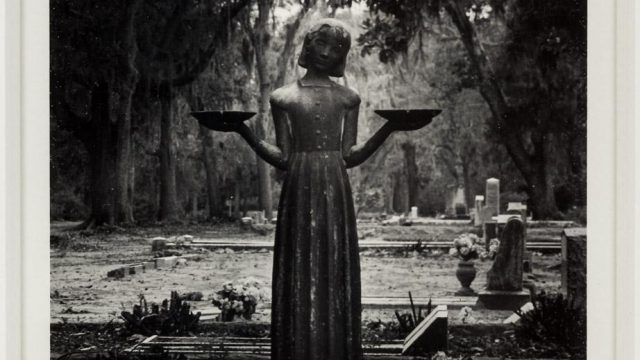You mustn’t be taken in by the moonlight and magnolias. There’s more to Savannah than that. Things can get very murky. – Jim Williams
Not every book is popular and influential enough to change the path of a city. But 1994’s Midnight in the Garden of Good and Evil certainly did. Savannah, Georgia is as much a character in the book as the flesh-and-blood people depicted in its pages (and perhaps more realistically depicted than some). The “Bird Girl” statue, designed to be both art and birdfeeder, is now cooling her heels in Telfair Museums, where tourists can watch her to their heart’s content without hassling the mourners in Bonaventure Cemetery, her old home. The tourist business in the town was never the same.
The book was a genuine phenomenon. Published the same year that Amazon was founded, it was featured in the window of countless bookstores and prominently displayed at libraries. Midnight in the Garden of Good and Evil was a Pulitzer Prize finalist and has still spent more time at the top of the New York Times bestseller list than any other book in history (216 weeks!). The iconic cover photo of the “Bird Girl” statue was on posters and tote bags, and the “Bird Girl” would appear in the posters for Clint Eastwood’s movie adaptation some years later. (You can buy a reproduction of your own online through Wal-Mart.) Midnight in the Garden of Good and Evil is one of the few books in modern publishing whose cover has never substantially changed.
On May 2, 1981, local character, antiques dealer, and historic preservationist Jim Williams shot his assistant and lover, local hustler Danny Lewis Hansford to death, These facts are almost the only ones that don’t get disputed over the course of the book, as Willliams, who claimed self-defense, endures four murder trials. He is eventually acquitted (though not quite exonerated in the court of public opinion), only to drop dead not far from the site of the murder months after his final trial. This is a book that is significantly stranger than fiction, even if you do take into account that author John Berendt took significant liberties in his storytelling.
The timeline is not quite right, and Berendt admits to fabricating and re-constructing some conversations in his pursuit of a good story, but the book has more important issues to address. Berendt’s prose is hypnotic, his characters a fascinating slice of an eccentric city, but through these trappings, he digs into topics far more serious. The glass closet figures heavily (“One thing we did do,” Georgia Fawcett, a preservationist, says about the slow process of restoring historic Savannah: “We got the bachelors interested.” She means men like Williams). So does homophobia, a lawyer whose hobby is raising the string of English bulldogs who serve as the University of Georgia’s mascot Uga, hoodoo magic, the criminal justice system, and life for those who, unlike Williams, took the risk of being openly LGBT+ in a Southern city in the 1980s. The most memorable of that cadre is not the late Danny Hansford, but the Lady Chablis, a trans nightclub singer who charms the author and steals scenes like she was born to. (She’s a highlight of the rather flabby Eastwood adaptation, where she successfully campaigned to play herself.)
I first read Midnight in the Garden of Good and Evil not that long after it came out, in a hardcover from the local library, out loud to my then-husband while he drove. It’s been long enough that I’m not sure what time of year we read it, because my memories are not of the New England landscape we passed through, but of shimmering heat and Spanish moss, of beautifully restored homes and glittering parties. Like the best books, Midnight in the Garden of Good and Evil transports the reader utterly, to a Southern city that–thanks to the book itself as much, if not more than, the murder–was never quite the same.
Here’s a writer from the Tallahassee Democrat reminiscing about a flight he took with The Lady Chablis, not long after her death. I’ve yet to read her memoir, Hiding My Candy, but it’s been on my list since it was published.

